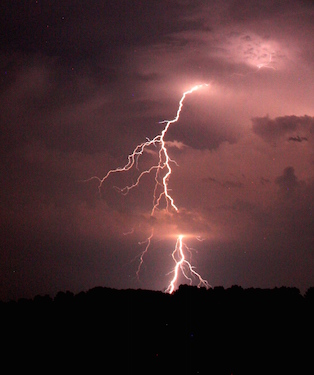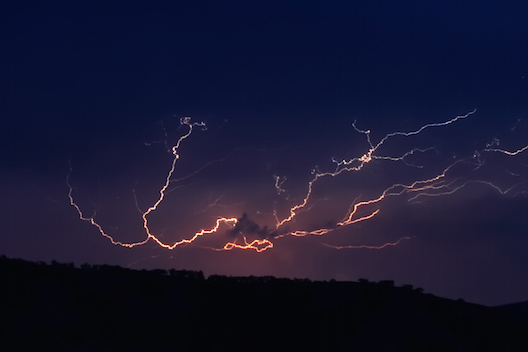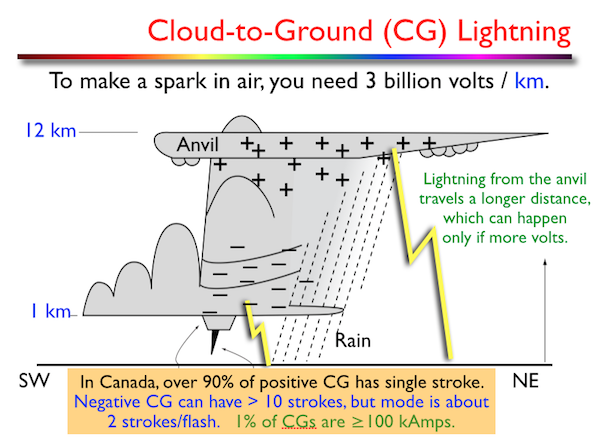Thunderstorm Hazards > Lightning & Precipitation Static
Learning Goal 4e. Identify thunderstorm hazards to flight &
how to avoid them. Lightning & P-static.
Lightning
This compelling video called "Transient" synchronizes high-speed
videos of lightning (displayed in slow motion) with dramatic music. https://www.youtube.com/watch?v=nBYZpsbu9ds
Lightning is a long (0.5 to 15 km), thin (≈1 cm) spark created in a thunderstorm. The lightning stroke can happen between a cloud and the ground (cloud-to-ground lightning, or CG lightning, first photo), between two adjacent clouds (next photo), within a single cloud, and from the cloud to clear air.


A wonderful YouTube video on lightning: https://www.youtube.com/watch?v=KO3H285CFRo
The same storm chaser caught a storm in 2017 with almost continuous lightning: https://www.youtube.com/watch?v=-vr_VTqs1eE
Lightning forms due to the collision of small ice crystals and small hailstones (graupel) inside a thunderstorm. The smaller ice crystals carrying positive charge are often carried up to the top of the thunderstorm by the updraft, to the region of the thunderstorm anvil. The larger heavier graupel carries negative charge toward the bottom of the storm as the graupel falls. As billions of particles collide, each contributing a small charge to the storm, the thunderstorm starts to accumulate large electrical charges, as shown in the figure below. When the voltage difference becomes great enough (3 billion volts / km), the normally insulative air will become ionized, making it a conductor of electricity. Thus, greater voltage build-up in a thunderstorm can cause longer lightning paths.
Aircraft do not attract lightning and do not cause lightning. But if an aircraft happens to fly near the path of an incipient lightning stroke, then the electricity will take advantage of the conductive skin of the aircraft. When this happens, lightning will briefly attach itself to one extremity of the aircraft (e.g. vertical stabilizer in the tail) and will depart at a different point (e.g. a wing tip).
Quote from FAA AIM section 7-1-28.
e. The probability of lightning strikes occurring to aircraft is greatest when operating at altitudes where temperatures are between minus 5 degrees Celsius and plus 5 degrees Celsius. Lightning can strike aircraft flying in the clear in the vicinity of a thunderstorm.
Quote from TC AIM section 2.7.1.
"Lightning can puncture the skin of an aircraft (i.e., can make a tiny pinhole in the aluminum skin), damage electronic equipment, cause engine failure and induce permanent error in magnetic compasses. Lightning can also cause compressor stalls or flameouts in aircraft with turbine engines."
If lightning flows through a plastic or composite component of the aircraft (such as a radome on the nose), then that component might fracture or get a larger hole. However, most lightning strikes usually cause negligible damage to aircraft. In fact, most commercial aircraft are hit by lightning about once per year. The fuel tanks don't explode. People inside are not electrocuted, because the electricity flows on the outside of the aluminum skin of the aircraft. Modern composite (carbon-fiber) aircraft have a wire screen imbedded in the composite material to conduct the lightning electricity away from key aircraft components.
This video shows lightning striking the wing of an airplane in flight: https://www.youtube.com/watch?v=8qI8z-RGH44&t=1s
Pilots flying near thunderstorms are encouraged to turn up cockpit lights to their highest intensity to minimize temporary blindness from lightning.
Extra info for experts; not needed for this course.
- Stull, 2017, Practical Meteorology. Chapter 15. Thunderstorm Hazards.
Precipitation static (P-static)
P-static is the name for the sparks that dance on the outside of an
aircraft. Sometimes the corona discharge will appear as filaments
of light writhing on the outside of the windshield — a phenomenon
called St.
Elmo's fire (see nice images via Google search on "st elmo's fire aircraft images"). The
sparks also cause static (crackling sounds) that you hear on the
radio.
The static electricity that creates these electrical discharges are
similar to (but more powerful than) the static charges
that build up on your body when wool and other fabrics rub against
certain materials, or when you rub your rubber-sole shoes against a
carpet. You experience this static charge as a spark when you
touch metal objects such as a door knob. In airplanes, the static
charge buildup is caused by precipitation particles as they rub against
the aircraft when the aircraft flys through clouds and
precipitation. See the info provided by the FAA:
Quote from FAA AIM section 7-5-11.
Precipitation static is caused by aircraft in flight coming in contact with uncharged particles. These particles can be rain, snow, fog, sleet, hail, volcanic ash, dust; any solid or liquid particles. When the aircraft strikes these neutral particles the positive element of the particle is reflected away from the aircraft and the negative particle adheres to the skin of the aircraft. In a very short period of time a substantial negative charge will develop on the skin of the aircraft.
If the aircraft is not equipped with static dischargers or has an ineffective static discharger system, when a sufficient negative voltage level is reached, the aircraft may go into “corona.” That is, it will discharge the static electricity from the extremities of the aircraft, such as the wing tips, horizontal stabilizer, vertical stabilizer, antenna, propeller tips, etc. This discharge of static electricity is the hiss, squeal, or crackle sounds you will hear in your headphones and is what we call P−static.
P−static can affect aircraft in the following ways:
- Complete loss of VHF (radio) communications
- Erroneous magnetic compass readings (30 percent in error)
- High-pitched squeal on audio
- Motor boat sound on audio
- Loss of all avionics (navigation and communication instruments) in clouds
- Very Low Frequency (VLF) navigation system inoperative most of the time
- Erratic instrument readouts
- Weak transmissions and poor receptivity of radios
- “St. Elmo’s Fire” on windshield — see nice images via Google search on "st elmo's fire aircraft images"
In conclusion: P-static does not directly damage the aircraft. It can, however, make radio communication and navigation difficult.
Extra info for experts; not needed for this course.
- A discussion by pilots of their experiences with St. Elmo's fire. See paper by Gerald Mulvey, John Miller and Jon Moriarty, 2017: "Atmospheric Electrical Phenomena: A Pilot's View". Weatherwise magazine, vol. 70 no. 5 (Sep/Oct 2017), pages 33-39. (accessible via the UBC Library). https://doi.org/10.1080/00431672.2017.1346437 .
- See overview of P-static in paper by Thornell (2001). doi:10.4271/2001-01-2933
- See FAA AIM section 7-5-11 or visit the P-static extra info page for HTML file
Key words: corona, graupel, lightning, cloud-to-ground (CG), ionized, P-static, St. Elmo's fire, stroke
Image credits. All figures by Roland Stull, except the first two photos: Cloud to ground lightning strike, New Boston, Texas © User:Griffinstorm / Wikimedia Commons / CC BY-SA 4.0. Cloud to cloud lightning strike, Swifts Creek, Australia © User:fir0002 / Flagstaffotos / Wikimedia Commons / GFDL 1.2.
